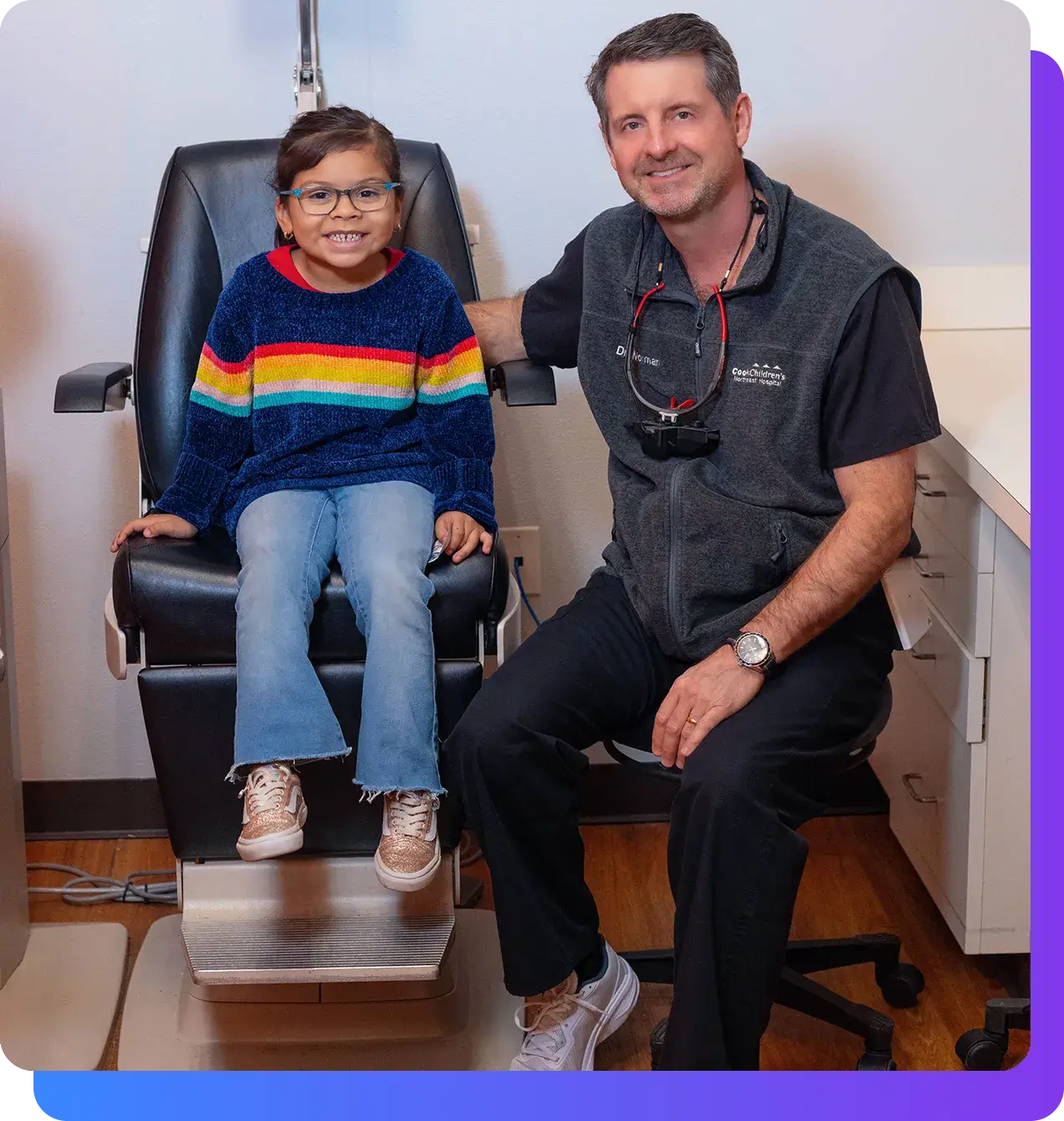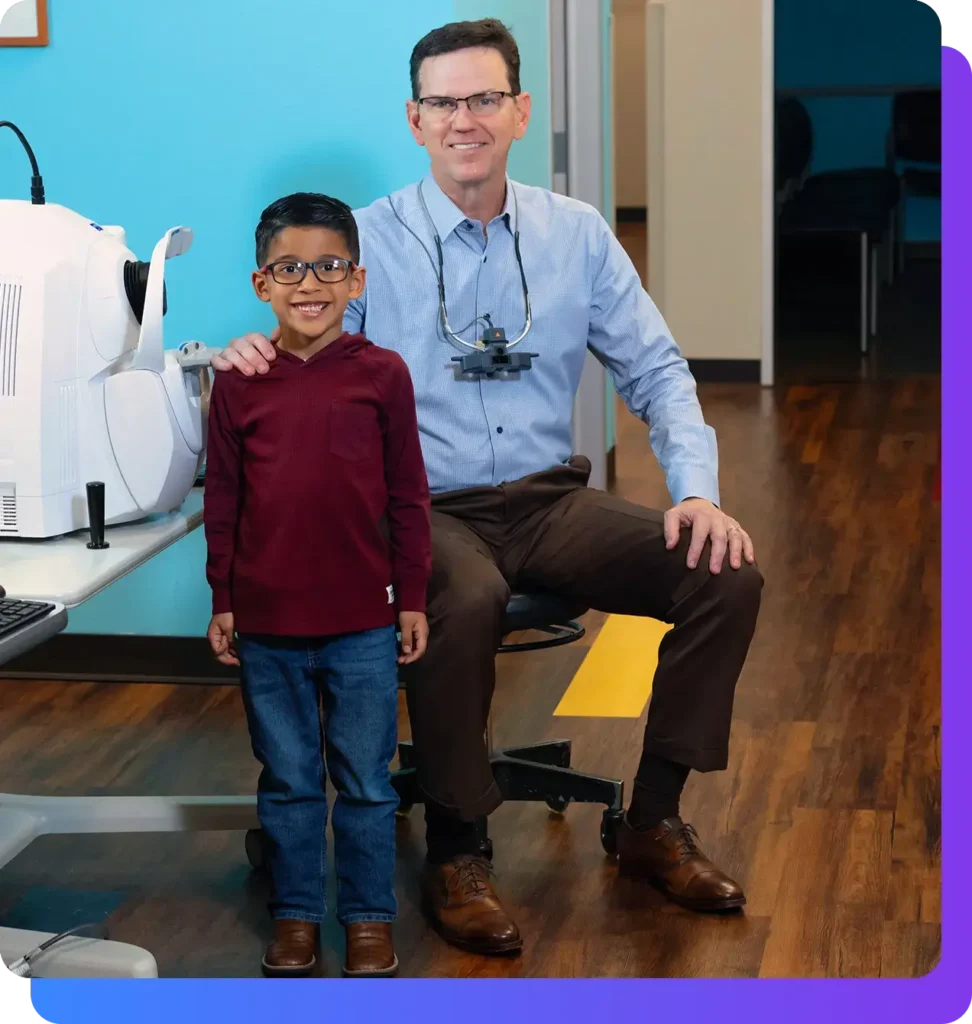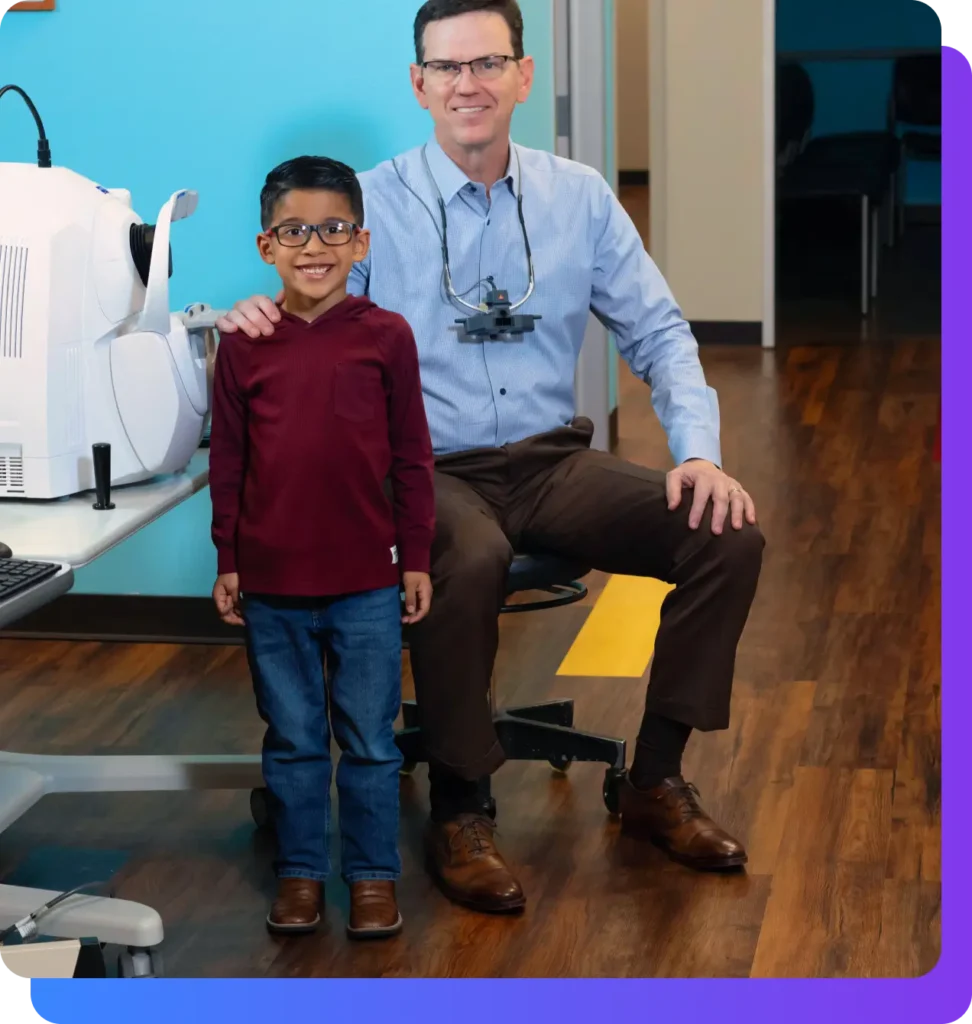Congenital Cataracts
Specialists in North Texas
Discovering that your child may have a congenital cataract can be an overwhelming experience. As a parent, you may feel anxious about the impact on your child’s vision and future, grappling with questions about what this means for their development and quality of life.
Expert Congenital Cataracts Treatment for North Texas
At Pediatric Eye Specialists, we understand these concerns and are here to give you the information you need. We will do everything we can for your child, offering expert care and compassionate support every step of the way. Let us discuss congenital cataracts—how they affect your child’s vision, the implications for their future, and the available treatment options. We are here to provide treatment, support, and encouragement.

The Basics: What are Congenital Cataracts?
Congenital cataracts, by definition, are cataracts that are present when a child is born. Congenital cataracts may be discovered when either you or a physician recognizes that the normal red reflex seen in a child’s eye is dim or nonexistent. Treating congenital cataracts early is absolutely essential. If you believe your child has a congenital cataract, please contact Pediatric Eye Specialists to be seen immediately.
A cataract is a clouding of the normal intraocular (inside the eye) crystalline lens. An intraocular lens normally allows light (the image that your child sees) to pass through and then focuses (acts like a pair of glasses inside of the eye) that light on the retina (the brain tissue on the back wall of the eye that lets your child see). When a lens becomes a cataract, light is no longer able to pass through to allow your child to see. Because of this, the only treatment for a congenital cataract is to surgically remove the lens.
Why Choose the Pediatric Eye Specialists for Your Child's Congenital Cataracts
The Most Experienced Team in North Texas
With over sixty-five years of collective pediatric ophthalmology expertise, we offer your child unparalleled collaborative care.
Five Convenient Locations
Easily accessible care with offices in Fort Worth, Denton, Keller, Mansfield, and Prosper,
Unrushed, Clear Communication
We take the time to discuss your child's diagnosis and treatment, ensuring all your questions are answered to ease your concerns.
Affiliated with Cook Children’s Hospital
Our partnership with Cook Children’s Hospital means if your child needs surgery, imaging, or other specialists, they will be treated in one of the nation’s leading pediatric hospitals.
Specialized Expertise
Our expertise means that more optometrists, doctors, and specialists refer their pediatric eye patients to Pediatric Eye Specialists than any other pediatric eye practice in North Texas.
Child and Family Focused
Kids love us, and we love kids! We provide a caring environment for your child and your family.
Advanced Diagnostic Technology
We have the most comprehensive pediatric diagnostic suite in North Texas, allowing for precise diagnosis and highly personalized treatment plans.
Every Child Needs Access to Expert Eye Care
Championing the right to sight, we help navigate insurance, cash pay, and Medicaid options to make superior eye care feasible for all children regardless of their socioeconomic status.

The Benefits of Treating Congenital Cataracts
Treating congenital cataracts early in children can significantly improve their quality of life and prevent long-term complications. Early intervention is crucial for normal visual development and can help avoid permanent vision impairments.
Success You Can Expect for Your Child
Restoration of Vision
The primary benefit of treating congenital cataracts is the restoration or significant improvement of vision. Surgical removal of the cataract and appropriate vision correction maximizes your child's sight and visual development.
Promotion of Normal Visual Development
Early treatment of congenital cataracts is crucial for normal visual development. Untreated cataracts can lead to permanent amblyopia ("lazy eye") or other visual impairments. Timely intervention maximizes the chances of good vision and the eyes working together effectively.
Prevention of Complications
Timely treatment can prevent complications that may arise from untreated cataracts, such as glaucoma, which can lead to further vision loss.
Enhanced Social and Cognitive Development
Good vision is vital for a child’s overall development. Treating congenital cataracts can improve a child’s ability to learn, interact with others, and explore their environment, thereby enhancing their social and cognitive development.
Increased Independence and Quality of Life
Children who receive treatment for congenital cataracts often experience an increased quality of life. Clearer vision allows for greater independence in daily activities and better engagement in educational and recreational activities.
Improved Emotional Well-being
Effective treatment can have a positive impact on a child's self-esteem and emotional well-being. Being able to see clearly can significantly improve a child’s confidence and interaction with their surroundings.
Real Stories,
Real Smiles.
“They were very good with my nonverbal toddler. It was the best doctor visit experience we have had yet. They were awesome, caring, and quick!.”

Amy Glover
Parent of Patient
“Today, Dr. Packwood saved my youngest from a life of blindness and worked a miracle for my family. I cannot express enough gratitude and thanks for their skillful surgery and expertise. 10 of 10 highly recommend.”

Atticus Lee
Parent of Patient
“The staff here is so amazing with my son. We had such a wonderful experience both at the office and for his surgery! I highly recommend Pediatric Eye Specialists!!!!“

Gianna Stutzman
Parent of Patient
“We are so grateful for the genuine care that Dr. Duff provided for our son Lorenzo, which prevented him from going blind! She is truly a gift to the community.“

JS Cocjin
Parent of Patient
“Professional, compassionate, kind and friendly. They took great care of my preemie baby from Day 1 of ROP. Very happy with how my daughter is progressing and has healthy eyes now.”

Suresh K.C.
Parent of Patient
“We’ve seen Dr. Hunt for the past 6 years since my daughter was 9 days old. We have multiple appointments each year and even eye surgery when she was 1. Our experience here has been fantastic every time and we highly recommend this group!.”

Mandy Edmondson
Parent of Patient
“Dr. Norman has always been very attentive and thorough with my daughter, who has Type 1 Diabetes. The staff are warm and always do their best to be accommodating. I highly recommend Dr. Norman.”

Tricia Moon
Parent of Patient
“Absolutely recommend! All around great experience! They made my son feel comfortable during the visit. Treatment was explained, and I walked out with no questions. I loved it. “

Cynthia Valero
Parent of Patient
“Great staff, great doctors; they know how to help ease kids’ fears and provide excellent service. Had to get my little one in same day for an eye injury, and they found a way to make it happen. Would 100% recommend.“

Kris K
Parent of Patient
Start your child’s journey to better vision today.
Embrace a future of clearer vision and confidence for your child. Contact us now to book your consultation at any of our convenient locations across the Metroplex.
Click to Explore Congenital Cataracts
Causes of Congenital Cataracts
Congenital cataracts, clouding of the eye’s lens present at birth, can stem from various causes, often making early detection and treatment crucial. Some congenital cataracts are associated with other systemic conditions, while other congenital cataracts are not associated with any other abnormalities. Bilateral cataracts (cataracts in both eyes) may be more likely to be associated with another abnormality than a unilateral cataract (cataract in one eye).
Genetic Disorders
Cataracts may be part of a larger genetic syndrome or result from specific gene mutations affecting eye development. Down syndrome, for example, is a frequent cause of bilateral cataracts.
Maternal infections During Pregnancy
Infections such as rubella, toxoplasmosis, herpes simplex, and cytomegalovirus can disrupt the development of the eye in the fetus, leading to congenital cataracts. These infections, particularly if they occur during critical stages of pregnancy, can interfere with the proper formation of the lens. Please note: these causes are rare. If your baby has a cataract, it is extremely unlikely that anything that you did or infections you suffered during pregnancy caused this. Your baby was likely going to get a cataract no matter how perfectly you took care of your baby while you were pregnant.
Metabolic Disorders
Conditions like galactosemia, where the body cannot properly process the sugar galactose, can lead to the accumulation of sugars in the lens, causing it to become opaque. Early diagnosis and dietary management of these metabolic disorders are crucial in preventing or minimizing the development of cataracts.
Understanding these causes is vital for Pediatric Eye Specialists in diagnosing and formulating an effective treatment plan for congenital cataracts.
Signs and Symptoms of Congenital Cataracts
Identifying congenital cataracts early in a child’s life is crucial for timely and effective treatment. Congenital cataracts can vary in severity, and symptoms may not always be immediately apparent, especially in infants. However, there are several signs and symptoms that parents and caregivers can look out for:
Cloudy or Gray Pupil or a White Reflex in Photographs
One of the most noticeable signs of a congenital cataract is a cloudy or gray appearance inside the pupil, which should normally be black. This cloudiness can be evident in certain lighting conditions and is caused by the opacity in the lens of the eye. A common way congenital cataracts are initially suspected is through leukocoria (a white or gray reflex) seen in photographs taken with a flash, instead of the typical “red-eye” effect.
Unusual Eye Movements
Infants or young children with cataracts might display nystagmus, which involves involuntary, rapid eye movements, or might display a squinting or strabismus (an inward crossing or outward crossing of an eye). This can be a response to impaired vision.
Poor Visual Tracking or Focus
A child with congenital cataracts may have difficulty focusing on or tracking objects. Parents might notice that their infant does not seem to follow faces or objects with their eyes as expected for their developmental stage.
Lack of Eye Contact or Reduced Responsiveness to Visual Stimuli
Infants with significant cataracts might not make eye contact or may seem less responsive to visual stimuli compared to their peers. This could be due to the reduced visual input resulting from the cataracts. It is important to note that very young babies do not track stimuli or see as well as older infants, even if there are no abnormalities in the eye.
Still Have Questions?
Congenital cataracts can sometimes be subtle, and regular pediatric eye examinations are crucial for early detection. If any of these signs are observed, consult a pediatric ophthalmologist for a comprehensive eye examination. Early diagnosis and intervention are key to ensuring the best possible outcomes for children with congenital cataracts.
Diagnosing Congenital Cataracts
The process of diagnosing congenital cataracts is comprehensive, beginning with a physical examination of the eye. This may include a red reflex test, a simple procedure where a light is shone into the eye to look for any opacities in the lens. An abnormal red reflex can be an early indicator of cataracts.
Understanding the diagnostic approach to congenital cataracts is essential for parents navigating this condition. This knowledge not only aids in early intervention but also in preparing for the treatment journey ahead.
Genetic Counseling
Genetic counseling is increasingly becoming a part of the diagnostic process in bilateral cataracts, especially in cases where there is a family history of congenital cataracts or when the cataracts are suspected to be part of a genetic syndrome. Genetic testing can identify specific mutations and help in understanding the risk for future children in the family.
Advanced Imaging Techniques
Advanced imaging techniques are pivotal in assessing the extent and nature of the cataracts. This can include ultrasonography, which provides a clear image of the eye’s internal structures. This techniques can help to ensure the remainder of the eye is normal and help determine the cause of the cataract, especially in cases of unilateral cataracts, guiding the decision-making for treatment.
Treatments for Congenital Cataracts
Congenital cataracts, a significant pediatric eye health concern, require a range of treatment methods tailored to the severity and unique circumstances of each case.
Treatment for Mild Cataracts in Children: Corrective Lenses
Occasionally, a pediatric cataract may be mild and vision may not be severely impacted. This is more common in older children who develop cataracts or children who have a strong family history of small, pediatric cataracts. In these milder cases of pediatric cataracts where vision is not severely impacted, nonsurgical methods, such as corrective lenses, may be all that is needed. Glasses or contact lenses help focus light onto the retina, thereby improving visual acuity. Additionally, dilating drops are sometimes useful in allowing the child to look around a small, central cataract. These options are beneficial when the cataracts are small.
Treatment for More Severe Cataracts in Children: Surgical Intervention
In more severe cases, where the cataract significantly obstructs vision, surgery is the recommended course of action. The primary goal of cataract surgery in infants and children is to remove the cloudy lens, a procedure known as lens aspiration. In an adult or older child, an intraocular lens (IOL) is implanted to replace the natural lens, restoring clarity and focusing power. The decision to implant an IOL is made based on various factors, including the child’s age, the health of the eye, and the potential for future growth and change in the eye’s length and surrounding structures. In congenital cataracts, intraocular lenses are almost never placed into the eye, as the eye is too small and the risk of complications is too great. A second surgery several years later may be able to place an intraocular lens in your child’s eye, if desired.
Our commitment at Pediatric Eye Specialists is to provide your child with the highest standard of care, combining medical expertise with compassion and understanding.
Typical Expected Outcomes for Congenital Cataract Treatments
The outcomes of congenital cataract treatment can be significantly positive, particularly when intervention occurs early. Following treatment, many children experience substantial improvements in visual acuity. However, it’s important for parents to have realistic expectations and understand that all children will need glasses or contact lenses after surgery, and without these interventions, visual development would be poor.
Realistic Expectations
While congenital cataract treatment can greatly enhance a child’s vision, ongoing care and future interventions may be needed as the child grows and their visual needs change. This long-term approach to care, focusing on the evolving needs of the child, is a cornerstone of pediatric ophthalmology and critical for ensuring the best possible outcomes for children with congenital cataracts.
Ongoing Monitoring
Ongoing monitoring is critical to managing potential complications, such as secondary glaucoma, a condition where increased pressure in the eye can lead to further vision loss. Regular eye examinations are essential to check for glaucoma and other issues like inflammation or retinal detachment.
The doctors at Pediatric Eye Specialists employ advanced surgical techniques to ensure the safety and effectiveness of the surgery. Postsurgical care is crucial to your child’s visual success and may include the use of eye drops to control inflammation and pressure within the eye.
Cataracts With Amblyopia
Secure a Brighter Future: Schedule You Child's Congenital Cataracts Consultation Today
Do not let congenital cataracts obscure your child’s vibrant future. Schedule an appointment with Pediatric Eye Specialists to ensure your child receives the expert diagnosis and care they deserve. Take the first step towards clear vision and a lifetime of possibilities for your child—contact us now.

Start your child’s journey to better vision today.
Embrace a future of clearer vision and confidence for your child. Contact us now to book your consultation at any of our convenient locations across the Metroplex.
How can corrective lenses help if my child has congenital cataracts?
Corrective lenses, including glasses or contact lenses, should be used after cataract surgery. They help focus light onto the retina to enhance visual perception, which is crucial after removal of a cataract.
Are congenital cataracts a sign of a more serious disease or genetic condition?
Congenital cataracts can be isolated incidents, but they may also indicate an underlying genetic disorder or systemic disease, such as oculocerebrorenal syndrome of Lowe, or a birth defect. Genetic counseling can often determine if the cataracts are part of a syndrome, such as Down syndrome/Trisomy 21. In older children, diseases such as diabetes or trauma can cause cataracts, but these are unlikely in the congenital patient.
Can pediatric eye surgery correct congenital cataracts caused by chickenpox or other viral infections during pregnancy?
Yes, eye surgery can correct cataracts caused by in utero infections like chickenpox. The surgery involves the removal of the cloudy lens, which can become opaque due to a virus crossing from the mother to the child in the uterus.
What is the role of a surgeon in congenital cataract treatment?
The surgeon, specializing in pediatric ophthalmology, performs the delicate eye surgery to remove the cataract. The procedure involves an anterior capsulotomy, which opens part of the lens capsule, followed by lens aspiration. A posterior capsulotomy is then typically performed, in addition to an anterior vitrectomy, to prevent scar tissue formation that would cloud your child’s vision again. In some cases, placement of an artificial lens is able to restore clarity to your child’s vision. If your child does not qualify for an artificial lens (based on age), glasses and/or contact lenses will be needed.
How does the mother’s health affect the risk of congenital cataracts in her child?
The mother’s health can significantly impact the risk. For example, untreated syphilis or uncontrolled diabetes during pregnancy can increase the risk of congenital cataracts. Proper prenatal care and vaccination can help mitigate these risks. While pregnant mothers should be cautious during their pregnancy, very few congenital cataracts are caused by anything that the mother could have done differently. Nearly every one of our patients with congenital cataracts developed cataracts through no fault of their mother. Please be cautious during pregnancy, but do not blame yourself for your baby’s cataract.
What is the prognosis after congenital cataract surgery?
The prognosis is guarded. In bilateral cataracts the prognosis can be good, especially with early detection and intervention. Postsurgery, children will require corrective lenses. Ongoing monitoring is essential to assess the need for further treatment and ensure the best visual outcomes. Ironically, in children with unilateral cataracts (one eye with a cataract), the prognosis for vision in the eye with the cataract is more guarded. We can further discuss this when we see you and your family.
Can congenital cataracts lead to other vision issues?
If left untreated, congenital cataracts can lead to other issues, such as amblyopia (a lazy eye), where the brain favors one eye over the other, or strabismus (misaligned eyes). These conditions are treatable with timely interventions and appropriate postoperative care.
What is aphakia, and how does it relate to congenital cataract surgery for my child?
Aphakia is the absence of the lens in the eye, which occurs after congenital cataract surgery when the cloudy lens is removed and not replaced with an artificial lens. All young babies who undergo congenital cataract surgery will be left aphakic. We can discuss the reasons for this protocol during your appointment, but after surgery your child will need either special contact lenses or glasses that provide the focusing power usually offered by the natural lens. This corrective measure is crucial to facilitate proper visual development after surgery.
How does heredity affect the likelihood of my child developing congenital cataracts?
Heredity plays a significant role in the development of congenital cataracts. If there is a family history of cataracts or related eye conditions, the risk may be higher due to inherited genetic factors. Pediatric Eye Specialists recommends regular eye screenings for children with a family history of cataracts. Some families have strong family histories of congenital, infantile, or pediatric cataracts.
What guidelines does the American Academy of Ophthalmology provide for treating pediatric cataracts?
The American Academy of Ophthalmology (AAO) and the American Association for Pediatric Ophthalmology and Strabismus (AAPOS) provide guidelines for the treatment of pediatric cataracts, including recommendations for surgery, intraocular lens implantation (in older children), and postoperative care to optimize visual outcomes. Every pediatric eye surgeon at Pediatric Eye Specialists is a member of the American Academy of Ophthalmology and of the American Association of Pediatric Ophthalmology and Strabismus (AAPOS). For up-to-date information on all pediatric ocular conditions, we strongly trust AAPOS and recommend visiting the AAPOS website for additional information.
How does persistent fetal vasculature present in congenital cataracts?
Persistent fetal vasculature (PHPV) is a condition where the blood vessels that nourish the developing lens during fetal growth do not regress as they should have by the time of a child’s birth. This can lead to congenital cataracts, which may be visible in the posterior segment of the eyeball during a pediatric eye examination. This is one of the most common causes of unilateral congenital cataracts and one of the main reasons that we might perform an ultrasound on your child’s eye during your visit.
How does preterm birth and low birth weight affect the risk of congenital cataracts in infants?
Infants born preterm or with low birth weight may be at an increased risk for various health conditions, including congenital cataracts. The developmental processes that occur in the later stages of pregnancy, including those affecting the eyes, may be incomplete in these babies. As such, careful monitoring of their vision is essential, and pediatric ophthalmologists often recommend regular eye examinations for early detection and treatment of conditions like cataracts, ensuring better long-term visual outcomes.
Can an injury to my child’s eye cause congenital cataracts to worsen or recur after treatment?
Injury to the eye is unlikely to cause congenital cataracts, as these typically develop before birth due to genetic or environmental factors. This is called prenatal development. However, trauma to the eye following treatment can affect overall eye health and potentially compromise the surgical outcome. It’s essential to protect your child’s eyes from injury and follow all postoperative care instructions to maintain the health of the eye after cataract removal.
How does modern medicine seek to ensure the safety of congenital cataract surgery in young children?
The practice of medicine, especially in pediatric ophthalmology, involves rigorous protocols that seek to ensure the safety and efficacy of congenital cataract surgery. This includes a comprehensive presurgical assessment, the use of age-appropriate anesthesia, and postoperative care tailored to the needs of young patients. Advances in medical knowledge, surgical techniques, technology, and postoperative care continue to improve the safety profile of these procedures for infants and children.
What is the difference between bilateral and unilateral cataracts in children?
Bilateral cataracts are present in both eyes, while unilateral cataracts affect only one eye. Bilateral cataracts are more commonly associated with systemic diseases or inherited cataract conditions, while unilateral cataracts may result from localized factors or be sporadic.
What is a posterior capsulotomy, and is it necessary for children with cataracts?
A posterior capsulotomy is a procedure performed to create an opening in the lens capsule behind the lens. In an adult, this is not performed during surgery. Due to the inability for a baby to sit still at a laser machine several months after surgery, posterior capsulotomies are the standard of care for most childhood cataracts.
What are intraocular lenses, and are they used in children?
Intraocular lenses (IOLs) are artificial lenses implanted in the eye to replace natural lenses removed during cataract surgery. In children, IOLs are used with consideration to the child’s age and ocular development to provide long-term visual correction. Using an analogy borrowed from Dr. Sharon Freedman at Duke Pediatric Eye Center, imagine picking out your child’s wedding shoes at the age of six weeks. You could look at mom’s feet or dad’s feet and the size of the baby feet right now, but ultimately, the size and shape of the child’s wedding shoes could only be a best guess. In the same way, when we choose the intraocular lens your child needs, we can only use the information available to us. Intraocular lenses are not safe in young babies, so many children will not be offered intraocular lenses during their first surgery. The timing for the placement of the secondary intraocular lens occurs after discussion between the doctor and the parents and will involve looking at the child’s individual needs. Some families choose intraocular lenses around the age of one; other families may decide their child does not yet need a lens and will decide to wait until the child is older. We will work with your family to determine what is best for your child.
How are ocular abnormalities associated with congenital cataracts managed?
Ocular abnormalities, such as structural defects in the eye that are present at birth, may accompany congenital cataracts. These are managed on a case-by-case basis, often requiring multidisciplinary care and possibly additional surgical interventions beyond cataract removal.
Can viral infections like measles cause congenital cataracts?
Yes, maternal infections such as measles or herpes simplex virus during pregnancy could increase the risk of congenital cataracts in infants due to the virus affecting the developing lens in utero. While we would like pregnant mothers to be cautious during their pregnancy, very few congenital cataracts are caused by anything the mother could have done differently.
Are children with health conditions like kidney or heart disease more prone to developing cataracts?
Children with certain systemic health issues, including kidney and heart disease, may have an increased risk of cataracts, either due to the disease itself, metabolic imbalances like hypoglycemia, or as a side effect of necessary treatments.
How does Patau syndrome relate to cataracts in children?
Patau syndrome, also known as Trisomy 13, is a genetic disorder that can feature a range of health issues, including ocular abnormalities like cataracts, as part of its presentation.
Can vaccinations for diseases like polio prevent cataracts?
While vaccinations for diseases like polio prevent that specific viral infection, they do not directly prevent cataracts. However, vaccinations for some infections known to cause congenital issues, such as rubella, can reduce the risk of cataracts if administered before pregnancy.
What is the connection between skin rash illnesses and congenital cataracts?
Some viral illnesses that cause a skin rash, such as measles or congenital rubella syndrome, can also affect the developing eyes in utero, potentially leading to congenital cataracts.
Is there a link between nerve damage and cataract development in children?
While nerve damage itself does not directly cause cataracts, conditions that affect the nerves, like diabetes, can lead to complications that may increase the risk of cataracts in children, especially if associated with hypoglycemia.
After congenital cataract surgery, will my child’s brain adapt to the changes in vision?
Yes, the brain is remarkably adaptable, especially in young children. After surgery, the brain will begin to process visual information more effectively, and with the help of visual rehabilitation, it can adjust to the changes, leading to improved visual outcomes. It is important to note that congenital cataracts, the recovery from cataract surgery, and the visual rehabilitation after cataract surgery, greatly differs from adult cataract treatment and recovery. An adult’s brain has already learned to use their affected eye. Treating a child’s congenital cataract has less to do with the surgery than the child’s brain learning to use that vision. This is the most significant conversation we will have with you about your baby’s eyesight and follow-up care is absolutely essential throughout their childhood. Pediatric Eye Specialists is committed to supporting you and helping your child achieve the best visual outcome.